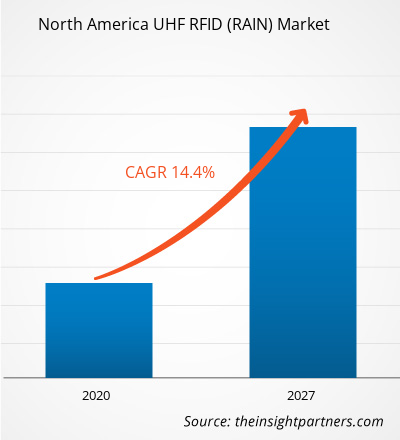The UHF RFID (RAIN) market in North America is expected to grow from US$ 838.34 million in 2019 to US$ 2,435.55 million by 2027; it is estimated to grow at a CAGR of 14.4% from 2020 to 2027.
The US, Canada, and Mexico are major economies in North America. Rising usage of RFID technologies in retail sector is the major factor driving the North America UHF RFID (RAIN) market. Continuous developments in inventory tracking technologies are driving the growth of the retail sector at an unprecedented rate. The sector boosts the reach of numerous businesses to customers, thereby providing them necessary exposure. The growing emphasis on online marketing tools, such as Facebook and Google ads, has been contributing to the boom in the retail sector. It is one of the mature industries in the US, where consumers are highly inclined toward online shopping. As per the facts stated by the Census Bureau of the Department of Commerce, the retail e-commerce sales in the US were US$ 160.3 billion in the first quarter of 2020, with an increase of 2.4% from the fourth quarter of 2019. In April 2019, Checkpoint Systems, a US-based RFID solution provider for retail, partnered with Impinj, a RAIN RFID solutions provider, to launch its first inlays with the Impinj M700 tag chip family. The inlays are 18% smaller made from 70% recycled content to set a new standard in the retail sector. Thus, such partnerships help UHF RFID market players launch advanced chips for readers, thereby allowing them to meet the dynamic requirements of retailers, and such progressive initiatives by market players have been fueling the market growth.North America has the highest adoption and growth rate of new technologies owing to favorable government policies to boost innovation and strengthen the infrastructure capabilities. Hence, any impact on industries is expected to affect the economic growth of the region in a negative manner. The US is one of the prominent markets for UHF RFID (RAIN) due to the growing retail and e-commerce, and healthcare sectors. The huge increase in the number of confirmed cases and rising reported deaths has affected these industries. The factory and business shutdowns across the US, Canada, and Mexico impact the adoption of the UHF RFID (RAIN). The retail sector has faced considerable shifts, consumer spending on groceries continue to increase. However, spending on apparel and other accessories decreased substantially in 2020. Moreover, in the mid-2020, the retail and e-commerce sales have increased gradually, leads to slight growth in the market in North America. RFID technology is also highly used in the healthcare industry to track their assets. To combat the virus, the region has started shipping vaccines and PPE kits within the region where RFID technology has made a comeback to track and authenticate test kits, PPE, and vaccines. Thus, this also leads to slight growth in the market. COVID-19 has had a severe impact on transportation and automotive, and trade activity. North America is home to many manufacturing and technology companies. Thus, the coronavirus outbreak's impact was quite severe in 2020 and likely in 2021. The negative impact of COVID-19 is short-term; it is likely to decrease in the coming years.
With the new features and technologies, vendors can attract new customers and expand their footprints in emerging markets. This factor is likely to drive the North America UHF RFID (RAIN) market. The North America UHF RFID (RAIN) market is expected to grow at a good CAGR during the forecast period.
- This FREE sample will include data analysis, ranging from market trends to estimates and forecasts.
North America UHF RFID (RAIN) Market Segmentation
North America UHF RFID (RAIN) Market – By Component
- Hardware
- Tags and Labels
- Readers
- Printers
- Other Hardware
- Software
- Services
North America UHF RFID (RAIN) Market – By Application
- Retail and Consumer Goods
- Logistics and Transportation
- Healthcare
- Manufacturing
- Other Applications
North America UHF RFID (RAIN) Market, by Country
- US
- Canada
- Mexico
North America UHF RFID (RAIN) Market - Companies Mentioned
- CAEN RFID S.r.l
- Convergence Systems Limited
- Impinj, Inc.
- Invengo Technology Pte. Ltd.
- Jadak- A Novanta Company
- Lowry Solutions Inc.
- Murata Manufacturing Co., Ltd.
- NXP Semiconductors N.V.
North America UHF RFID (RAIN) Report Scope
| Report Attribute | Details |
|---|---|
| Market size in 2019 | US$ 838.34 Million |
| Market Size by 2027 | US$ 2,435.55 Million |
| Global CAGR (2020 - 2027) | 14.4% |
| Historical Data | 2017-2018 |
| Forecast period | 2020-2027 |
| Segments Covered |
By Component
|
| Regions and Countries Covered | North America
|
| Market leaders and key company profiles |
- Historical Analysis (2 Years), Base Year, Forecast (7 Years) with CAGR
- PEST and SWOT Analysis
- Market Size Value / Volume - Global, Regional, Country
- Industry and Competitive Landscape
- Excel Dataset



Report Coverage
Revenue forecast, Company Analysis, Industry landscape, Growth factors, and Trends

Segment Covered
Component and Application

Regional Scope
North America, Europe, Asia Pacific, Middle East & Africa, South & Central America

Country Scope
US, Canada
Trends and growth analysis reports related to Electronics and Semiconductor : READ MORE..
The List of Companies - North America UHF RFID (RAIN) Market
- CAEN RFID S.r.l
- Convergence Systems Limited
- Impinj, Inc.
- Invengo Technology Pte. Ltd.
- Jadak- A Novanta Company
- Lowry Solutions Inc.
- Murata Manufacturing Co., Ltd.
- NXP Semiconductors N.V.

 Get Free Sample For
Get Free Sample For